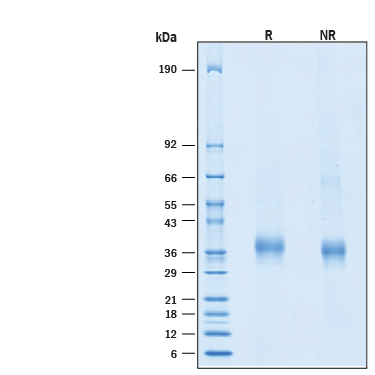Recombinant Cynomolgus BLAME/SLAMF8 His-tag Protein, CF
Recombinant Cynomolgus BLAME/SLAMF8 His-tag Protein, CF Summary
Product Specifications
Ala23-Asp233, with a C-terminal 6-His tag
Analysis
Product Datasheets
Carrier Free
CF stands for Carrier Free (CF). We typically add Bovine Serum Albumin (BSA) as a carrier protein to our recombinant proteins. Adding a carrier protein enhances protein stability, increases shelf-life, and allows the recombinant protein to be stored at a more dilute concentration. The carrier free version does not contain BSA.
In general, we advise purchasing the recombinant protein with BSA for use in cell or tissue culture, or as an ELISA standard. In contrast, the carrier free protein is recommended for applications, in which the presence of BSA could interfere.
11395-BL
| Formulation | Lyophilized from a 0.2 μm filtered solution in PBS with Trehalose. See Certificate of Analysis for details. |
| Reconstitution | Reconstitute at 250 μg/mL in PBS. |
| Shipping | The product is shipped at ambient temperature. Upon receipt, store it immediately at the temperature recommended below. |
| Stability & Storage: | Use a manual defrost freezer and avoid repeated freeze-thaw cycles.
|
Scientific Data
 View Larger
View Larger
Recombinant Cynomolgus Monkey BLAME/SLAMF8 His-tag (Catalog # 11395-BL) binds Biotinylated Recombinant Cynomolgus Monkey BLAME/SLAMF8 Fc Chimera with an ED50 of 60.0-720 ng/mL.
 View Larger
View Larger
2 μg/lane of Recombinant Cynomolgus Monkey BLAME/SLAMF8 His-tag Protein (Catalog # 11395-BL) was resolved with SDS-PAGE under reducing (R) and non-reducing (NR) conditions and visualized by Coomassie® Blue staining, showing bands at 31-39 kDa, under reducing conditions.
Reconstitution Calculator
Background: BLAME/SLAMF8
B-lymphocyte activator macrophage expressed (BLAME), also known as SLAMF8, is a type I transmembrane protein that belongs to the CD2 subset of immunoglobulin superfamily cell receptors. The SLAM family is comprised of nine surface receptors, expressed mainly on hematopoietic cells, and they have been shown to function as adhesion molecules and modulators of immune responses (1). BLAME, along with SLAMF2 and SLAMF9, are considered atypical SLAM family members due to the low homology in their cytoplasmic domains compared to the rest of the SLAM family (2). Mature cynomologus BLAME consists of an extracellular domain (ECD) with an IgV and an IgC2 domain, a transmembrane segment, and a short cytoplasmic domain. Within the ECD, cynomologus BLAME shares 96% amino acid sequence identity with human BLAME. BLAME is expressed by various myeloid cells, such as neutrophils, macrophages, and dendritic cells (3). BLAME suppresses macrophage function but enhances the growth of neoplastic mast cells via SHP-2 (4). BLAME negatively regulates the activity of PKC-δ, which phosphorylates the p40phox subunit of the NOX2 complex (5). BLAME is abundantly expressed in T cells in pediatric cancers and Epstein-Barr virus-positive gastric cancers and is a potential immunotherapy target for several diseases (6-8). Higher SLAMF8 expression may predict better anti-PD1 immunotherapy efficacy in GI cancer (9).
- Shachar, I. et al. (2019) Clin. Immunol. 204:23.
- Dragovich, M.A. and Mor, A. (2018) Autoimmunity reviews, 17:674.
- Wang, G. et al. (2015) PloS one, 10:e0121968.
- Sugimoto, A. et al. (2018) Exp. Dermatol. 27:641.
- Wang, G. et al. (2012) J. Immunol. 188:5829.
- Orentas, R.J. et al. (2012) Front Oncol. 2:194.
- Sugimoto, A. et al. (2020) Sci. Rep. 10:2505.
- Zhang, Q. et al. (2019) J. Clin. Oncol. 37:e14078.
- Zhang Q. et al. (2021) Clin. Transl. Immunology. 10:1347.
FAQs
No product specific FAQs exist for this product, however you may
View all Proteins and Enzyme FAQsReviews for Recombinant Cynomolgus BLAME/SLAMF8 His-tag Protein, CF
There are currently no reviews for this product. Be the first to review Recombinant Cynomolgus BLAME/SLAMF8 His-tag Protein, CF and earn rewards!
Have you used Recombinant Cynomolgus BLAME/SLAMF8 His-tag Protein, CF?
Submit a review and receive an Amazon gift card.
$25/€18/£15/$25CAN/¥75 Yuan/¥1250 Yen for a review with an image
$10/€7/£6/$10 CAD/¥70 Yuan/¥1110 Yen for a review without an image
